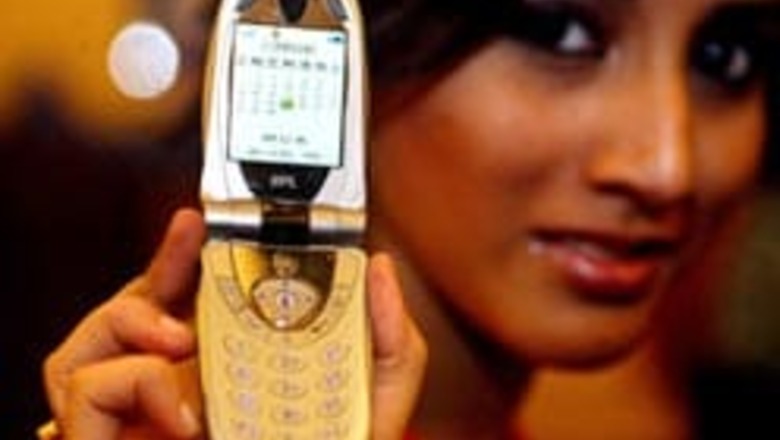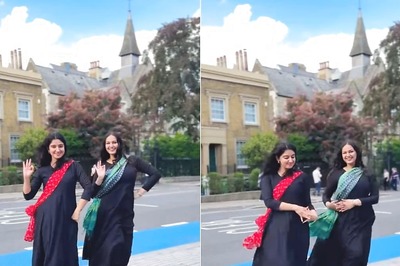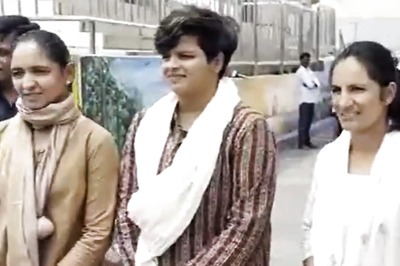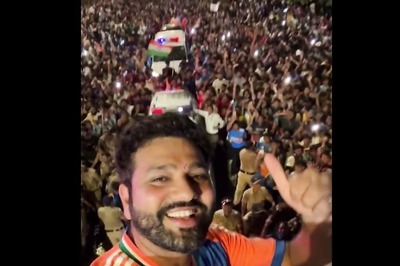
views
Yokohama: Masked and demure, she speaks from the tiny screen of a cell phone like a thumb-size fairy forever trapped inside. ''Welcome home,'' she says softly to the viewer. ''Speak to me about anything.''
The minuscule video is among the works on display at a film festival that opened Friday in this Japanese port town, featuring 48 movies, all shot on camera-equipped cell phones.
Hazy and raw but urgently personal, these pocket-size statements on film, like Yuka Kojima's five-minute ''Thumb Girl,'' were selected from more than 400 entries in an international contest.
The works, streaming on monitors of cell phones strapped to tables, are filled with everyday shots, some literally taken on the run with streets and cars whizzing past in a blur.
They have a voyeuristic feel because the cell phone is so unobtrusive. Devoid of the typical grandeur of standard films, they offer grainy but patiently taken close-ups that don't rely on zooms and other fancy editing techniques.
The Pocket Films Festival in Japan, which organizers say is the first in this nation, marks yet another use for the omnipresent portable phone here, already used to exchange e-mail, surf the Internet, read novels and navigate on miniature digital maps.
Making movies with them was simply a logical next step.
The works also point to an important emerging art form, says Masaki Fujihata, film professor at the Tokyo National University of Fine Arts and Music and one of the festival's judges.
''The cell phone is something you always carry around and so you can roll the camera on a whim,'' he said. ''There's such an intimacy between the work and its creator. It's spontaneous.''
Fujihata said he was particularly fond of the nine-minute ''Walkers,'' whose main character is a pair of sneakers that takes a trip on a train.
Whether such works hold appeal beyond film buffs is still in doubt.
Yukio Anagawa, an employee at a telecommunications company, who came to check out the festival, was baffled by Walkers.
''It's not that entertaining,'' said the 28-year-old fan of Hollywood movies. ''It's sure different from regular movies.''
But Fujihata and other experts say the medium is opening up the world of film-making to masses of amateurs.
Unlike regular films that require lots of money, people and time, the cell phone film is an easy cheap one-person operation. Even its relatively poor visual quality can be an advantage, often making for arty imagery, they say.
Many of the works, including ''Thumb Girl,'' was edited as digital files on a personal computer.
''I wanted my work to highlight the cell phone as interactive, something that people talk to,'' said Kojima, 20, a university student and ''Thumb Girl'' director.
The woman in her movie is a fantasy companion who eases human suffering by always being a willing listener, she said.
''It's so painful to feel pain but not have anyone to talk about the pain,'' Kojima said.
The festival has attracted some entries from outside Japan, including ''Seeking Truth'' by Weilong Hong from Singapore, which shows a young man with a cell phone walking in an alley, except everyone around him is walking backward.
In ''Remember,'' by Yang Duck-kyue from South Korea, layers of sepia-toned photos are torn on the footage, one after the other, like a collage of fading memories.
The cell phone film festival debuted in France in 2005. It's the first year Japan is having a version of the festival, which is showing some past French works in homage.
''The cell phone is an extremely personal tool. It's almost part of your body,'' said Jean-Louis Boissier, a French media artist and professor at University of Paris 8, in town for the festival.
''Half the world's population owns a cell phone. Art that comes from such numbers holds potential for historic change, '' he said.
Boissier said the cell phone is unique in not only working as a camera but also as a projector that shows video on handheld screens.
''Passerby,'' a witty puzzle-like piece by Michiko Tsuda, 27, a graduate student, uses a split screen to show images taken on two cell phones, one held by a man in the men's room and the other by a woman in the women's room.
They each take video of their own image in a mirror, wander into the hallway, where they meet and then switch cell phones, all the while recording video.
''We are usually not so conscious about who is taking an image,'' Tsuda said. ''But an image is always intentionally being taken by someone.''
















Comments
0 comment